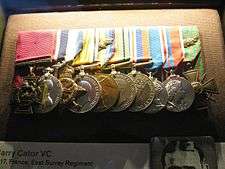Harry Cator
| Harry Cator | |
|---|---|
|
The medals of Harry Cator on display at the Ashcroft Gallery, Imperial War Museum | |
| Born |
24 January 1894 Drayton, Norfolk |
| Died |
7 April 1966 Norwich, Norfolk |
| Buried at | Sprowston Cemetery |
| Allegiance |
|
| Service/branch |
|
| Years of service | 1914 - 1947 |
| Rank | Captain |
| Unit |
The East Surrey Regiment Home Guard |
| Battles/wars |
World War I World War II |
| Awards |
Victoria Cross Military Medal Croix de Guerre (France) |
Harry Cator VC, MM (24 January 1894 – 7 April 1966) was an English recipient of the Victoria Cross, the highest and most prestigious award for gallantry in the face of the enemy that can be awarded to British and Commonwealth forces.
He was born in Drayton in Norfolk to a railway worker. After leaving school, he was a porter on the London Midland and Great Northern Joint Line before joining a building contractor in Great Yarmouth.
He joined the British Army in September 1914, and arrived on the Western Front in June 1915 already a sergeant in the 7th Battalion, The East Surrey Regiment. In 1916 at the time of the Somme Offensive, he was awarded the Military Medal for bringing back 36 wounded men from no-mans land.
He earned his VC during the Arras offensive. On 9 April 1917 near Arras, Sergeant Cator's platoon had suffered heavy casualties from a hostile machine-gun. Under heavy fire the sergeant, with one man, advanced across the open to attack the gun and when his companion was killed, he went on alone. Picking up a Lewis gun and some ammunition drums on his way, he succeeded in reaching the enemy trench and sighting another hostile machine-gun, he killed the entire team and the officer. He held the end of the trench with such effect that a bombing squad were able to capture 100 prisoners and five machine-guns.[1]
A few days later he was injured by an exploding shell. It was shortly after that the award of the VC and the French Croix de Guerre were announced. After the war he worked as a postman and as a civil servant.
Cator served with the rank of captain in the Home Guard during the Second World War, and was commandant for a prisoner-of-war camp. He retired from the Army in December 1947. He died in 1966 in Norwich on 7 April and is buried in Sprowston cemetery.[2]
His VC medal is one of many in the Lord Ashcroft Gallery at the Imperial War Museum.
References
- Notes
- ↑ The London Gazette: (Supplement) no. 30122. p. 5704. 8 June 1917. Retrieved 5 April 2015
- ↑ Queens Royal Surreys
- References
- Snelling, Steve (13 November 2010), "Epic Salute to Norfolk VC Heroes: Tribute to modest man and one of the bravest", Eastern Daily Press, pp. Sunday 2–3
